Single-photon detectors (SPDs) underpin
a host of new areas in optical physics, one of which is quantum cryptography –
or, more correctly, quantum key distribution (QKD) – an application that is
already on the fringes of commercial exploitation.
Recent advances in detector technologies have enabled secure quantum
transmission over record distances, but the impact of new detector technologies
goes beyond that of the quantum information world. SPDs are also poised to significantly
affect existing optical fields such as astronomy, laser ranging, remote sensing
and biomedical imaging.
Light is fundamentally composed of individual packets of energy
known as photons. The energy of a single photon at visible or infrared wavelengths
is around 1 eV (approximately 10–19 J), and detecting such a small amount of energy
poses a challenge.
Conventional SPDs are based on photomultipliers and avalanche
photodiodes, with silicon-based devices now commercially available in a number of
device geometries. For wavelengths above 1000 nm, InGaAs/InP single-photon avalanche
diode detectors are commonly used.
In the past few years, there has been a flurry of research into
detectors based on superconducting materials, which has yielded excellent results,
particularly for infrared operation. This focus has been spurred in part by the
pursuit of optical quantum information applications such as QKD.
In quantum cryptography, single photons can be used as signals
in a communication channel that cannot be intercepted without inducing a detectable
change in that channel.
“Quantum key distribution encodes binary ‘1’
and ‘0’ values onto photons in such a way that an eavesdropper performing
a measurement on the photons will change the state of a sufficient proportion of
the photon streams to leave a ‘fingerprint’ which can be detected by
the authorized users,” said professor Gerald Buller at the School of Engineering
and Physical Sciences, Heriot-Watt University, Edinburgh, UK.
While QKD protocols exist that use signals containing many photons
and that do not require SPDs (so-called continuous-variable schemes), to date, single-photon-based
protocols have been demonstrated over significantly longer distances than continuous-variable
protocols.
In classical telecommunications systems, the presence of a pulse
containing at least a certain number of photons denotes a binary “1”
value, and the absence of such a pulse denotes a binary “0” value. The
difference with QKD is that the 1’s and 0’s are both encoded on the
quantum states of single photons. So unlike the classical setup, the absence of
a photon in QKD is a null result, which does not contribute any information to the
cryptographic key.
“The transmitted signal is subject to attenuation in the
transmission medium, and traditional optical amplification techniques are not applicable.
The ultimate limit in range is governed by detection at the single-photon level,”
Buller said. “Consequently, it is important that any single-photon detector
used in quantum key distribution efficiently converts incoming photons into measurable
electrical pulses and does not produce a high number of nonphoton-induced output
electrical pulses – or dark counts.”
The efficiency and noise properties of SPDs play critical roles
in determining the distance over which a system can operate successfully. Spurious
detection events (caused by detector dark counts) are a major contribution to error
rates in optical quantum information processing schemes that operate over long distances.
This makes detectors with low dark count rates extremely valuable.
Semiconductor versus superconductor
Long-distance communication is most efficiently channeled via
optical fibers at a wavelength of 1550 nm – where losses in the fiber are
at their lowest. Other advanced optical components such as on-chip waveguides are
also tailored to this wavelength, which means that there is considerable interest
in developing SPDs that operate at the telecoms wavelength.
It is at this point that semiconductor SPDs fall down. As Dr.
Robert Hadfield said, “Semiconductor SPDs at these [telecoms] wavelengths
(based on InGaAs rather than Si) typically perform poorly and require gating in
order to mitigate for very high dark count rates.” Hadfield heads up a research
group at Heriot-Watt University that focuses on the development and applications
of superconducting single-photon detectors.
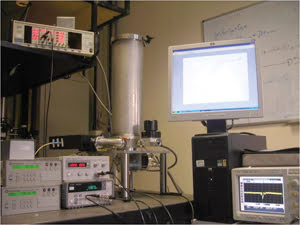
Superconducting single-photon detector system based on a closed-cycle
refrigerator. Courtesy of Heriot-Watt University.
Another major drawback exhibited by semiconductor materials is
that they become transparent when the energy of a photon falls below the gap energy.
For example, in silicon, excellent detectors operating at or near room temperature
are available for the visible and near-infrared range, but sensitivity drops abruptly
at wavelengths above around 1 μm.
Superconducting materials do not suffer from this shortcoming
and are, in principle, sensitive to photons ranging from x-ray to terahertz wavelengths.
Even though superconductors have to operate at cryogenic temperatures, this in turn
gives them the advantage of an extremely good signal-to-noise ratio.
One such example is the superconducting nanowire single-photon
detector (SNSPD) based on niobium nitride. Between 2001 and 2002, pioneering research
on this device was performed by the Gol’tsman group at Moscow State Pedagogical
University, in collaboration with the Sobolewski group at the University of Rochester
in New York. Approximately 100 nm wide and 4 nm thick, these wires are cooled to
below their critical temperature (typically in the region of 4 K) and are biased
with a current close to the critical current density.
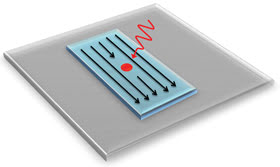
This concept drawing illustrates
a superconducting nanowire single-photon detector. Courtesy of Robert Hadfield,
Heriot-Watt University, Edinburgh, UK.
“When a photon is absorbed in the wire, it locally increases
the temperature. This hot spot leads to a localized increase in the resistance of
the wire and produces a voltage pulse which can be amplified and utilized by following
electronics,” Buller said.
In 2005, as part of a DARPA-funded program, a group at the National
Institute of Standards and Technology (NIST) in Boulder, Colo., led by Dr. Sae Woo
Nam demonstrated that these SNSPDs can be installed in a compact cryocooler system
that does not use liquid cryogens. The SNSPD packaging requires not only fast electronic
readout but also an optical fiber coupling that stays aligned as the device is cooled
to its operating temperature of 4.2 K. This robust optoelectromechanical packaging
has enabled the SNSPD to be widely used by NIST and its collaborators for various
system demonstrations.
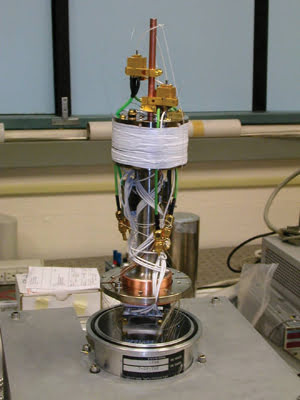
A photograph of the interior of the liquid cryogen-free cryostat
system. Two SNSPD modules are shown in this image. Courtesy of NIST Optoelectronics
Div.
Since these detectors have low timing jitter and low dark counts,
they offer unique advantages in applications such as high depth precision time-of-flight
ranging. Buller and colleagues at Heriot-Watt University, along with Nam and Hadfield
from NIST, first proved this concept in 2007 in a paper published in Optics Letters.
Perhaps the most remarkable feat achieved thanks to superconducting
nanowires is their use in groundbreaking quantum cryptography demonstrations. In
2007, Hadfield was part of a team of scientists from Stanford University, NIST and
Japan’s Nippon Telegraph and Telephone Corp. that achieved world-record results
in long-distance, high-bit-rate quantum key distribution in optical fiber, in an
experiment performed at Stanford University.
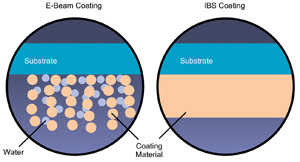
A fully packaged SNSPD module aligned
to a single-mode optical fiber. The SNSPD chip (not visible) is attached to the
base piece of the package, and electrical connections are made to the back of the
module, as shown on the right. Courtesy of NIST Optoelectronics Div.
In their paper published in Nature Photonics, they reported the
first QKD experiment to demonstrate that secure keys could be transmitted over 42-dB
channel loss and 200 km of optical fiber. The low-noise superconducting nanowires
allow secure key transmission over a record distance.
NIST considers other apps
While the ability to detect photons with higher sensitivity and
lower noise is pushing the limits of quantum cryptography, other areas also stand
to benefit. In fact, scientists at NIST are looking at applications ranging from
fundamental particle studies to extending the optical power of metrology to the
single-photon level.
“Single-photon detectors can enable more sensitive, accurate
and faster measurements than otherwise possible and are used to increase our basic
scientific knowledge, assist in electronics manufacturing and help determine drug
delivery efficiency,” said Joshua Bienfang, a physicist in the quantum telecommunications
group in the Electron and Optical Physics Div. at NIST.
“In more esoteric research applications, single-photon detectors
represent a critical link between the quantum world and the classical world. We
can detect signals from single quantum emitters, such as individual atoms or quantum
dots, and thereby gain an important perspective on processes internal to these minute
structures,” Bienfang added.
Some of NIST’s longer-term research projects involve developing
techniques and procedures for characterizing single-photon devices and applying
them in measurement applications that make use of uniquely quantum states of light.
One goal is to develop techniques to characterize single-photon devices with uncertainties
below the 10 parts-per-million level.
Another exciting application lies in long-distance optical communication.
NASA has been investigating the use of optical photons for communicating over interplanetary
and, more recently, lunar distances.
According to NIST’s Nam, the reduction in cost, footprint
and weight of transmitters, as well as their increased energy efficiency, makes
the prospect of communicating with optical photons highly attractive. The development
of large arrays of single-photon detectors is essential for this application.
The future of SPDs
Superconducting detectors of various types have enjoyed a long
history in fields such as astronomy, but a huge barrier to their use in other areas
has been the cumbersome cryogenic coolers that are required. however, with the advent
of robust, low-cost closed-cycle refrigeration, the need for liquid cryogens has
been eliminated. This has opened the field to a wider range of applications outside
of the lab – even reaching so far as airborne and space-based environments.
For example, Heriot-Watt’s Buller and colleagues have developed
a long-range 3-D depth profiler that operates with low light levels over distances
of up to 5 km. It can produce 3-D images of noncooperative targets with eye-safe
transmitted power levels.
The current generation of superconducting nanowire SPDs measures
around 10 μm in diameter, which is suitable for coupling to single-mode optical
fibers. In the future, superconducting single-photon detector arrays with large
active areas would have a dramatic impact. This would allow efficient free-space
coupling to devices and would in effect create a high-speed infrared single-photon
camera.
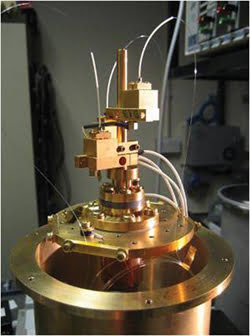
Fiber-coupled superconducting single-photon detectors mounted in a closed-cycle refrigerator.
Courtesy of Heriot-Watt University.
Efforts by Hadfield’s group are also under way to integrate
superconducting nanowire detectors on-chip with other optical components such as
optical waveguides and plasmonic structures in a step toward realizing optical quantum
computers.
While superconducting detectors may be claiming the lion’s
share of research efforts, their semiconducting counterparts are not being completely
overlooked. Silicon SPDs typically only operate efficiently for light with wavelengths
that lie in the 400- to 1000-nm range. To achieve improved near-infrared efficiency,
the inclusion of germanium into silicon avalanche structures is a way forward being
pursued by several groups, including Buller’s, which is working in conjunction
with the UK Silicon Photonics consortium.
Scientists at NIST are also developing semiconductor SPDs that
can support increased count rates.
“Historically, this has been a low priority in the development
of SPDs, but it is now relatively easy to provide optical signals at repetition
rates that are many orders of magnitude higher than the maximum count rate of most
widely available [single-photon avalanche diodes],” Bienfang said.
There have been some hopeful demonstrations of high count rates
in InGaAs/InP avalanche diodes, and Bienfang’s group hopes to expand upon
these approaches and reduce the gap by up to one order of magnitude.